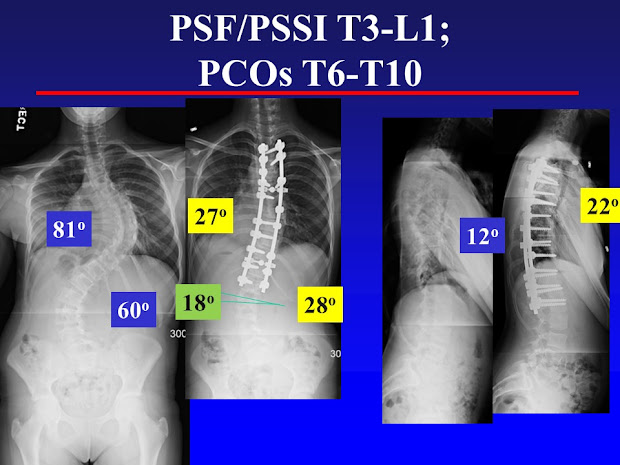In the last blog post I presented the position that 100% correction of the three-dimensional spinal deformity is NOT needed for optimal painless, long-term function.
However, to create the ideal aesthetic or cosmetic appearance of the body, from shoulders to the hips, achieving >90% correction is probably what is needed to completely normalize
the body symmetry, including correction of the chest or rib deformity.
This leads us to corollary
questions of the original question:
Is >90% correction achievable?
Is it safe?
Is appropriate?
The aesthetic or cosmetic appearance of the body is impacted
by the spinal alignment, ribs, and muscle development. Hence, if complete normalization of
appearance is desired, then all structures from the shoulder to the hips also
need to be corrected. In scoliosis
surgery we only directly operate on and correct the spinal alignment. The ribs and muscles which are attached to
the spine are secondarily, passively or indirectly improved as the scoliosis is
corrected and untwisted.
The next question we need to ask is if we want >90%
correction: How much surgery, or additional procedures, are needed to get to
>90% correction? Performing more
procedures takes additional surgical time, which means the patient is asleep
under general anesthesia longer, and the wound is opened longer. As the surgical time is extended there are
increasing risks of complications, such a blood loss (and need for blood
transfusions), surgical site or wound infections, neurological deficits, lung
complications (due to thoracoplasties or cutting of the ribs), and on and on.
It is difficult to quantify the amount of risk additional
procedures will add to a surgical procedure.
The amount of risk depends on which procedures, the number of them
performed and patient medical issues/comorbidities. As surgeons we constantly make judgements as
to how to maximize correction/outcome and minimize complications. It is not an easy, straightforward
decision-making process.
As we do more and more procedures to correct the alignment
(horizontal axis), the risk of complications per procedure gradually increases,
and the amount of correction for each procedure declines.
This circles us back to is to the question: is it
appropriate to achieve >90% correction.
If you cannot tell from my blog I don’t aim for >90% correction for
most surgeries for most patients. I think this much correction being comparable
to that old adage: A long run for short slide.
Most patients cannot tell between 70%, 80% or 90% correction, except by
looking at the x-rays.
I prefer to focus surgically on long-term painless function
with, ideally, no surgical complications and a rapid return to normal
activities.
In the above case there was a significant deformity correction,
from 81 degrees to 27 degrees, but it’s not perfectly straight. However she is nicely balanced.
As you see she looks excellent with balanced shoulder and
waist.
There is nice correction of her body alignment.
Should we have gone for 100% correction? I think not……


